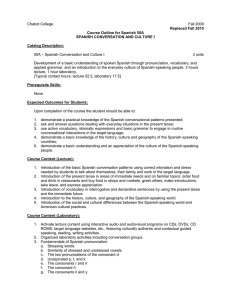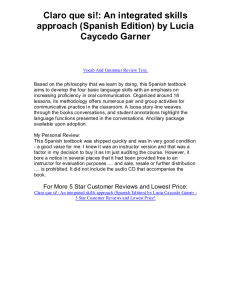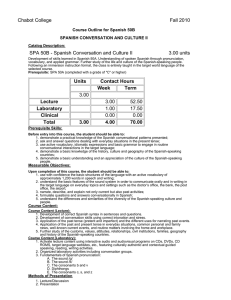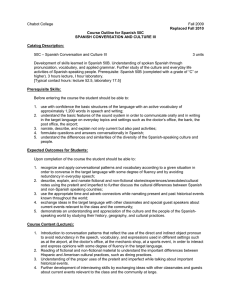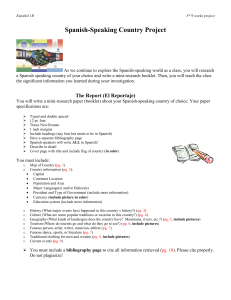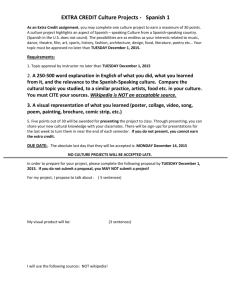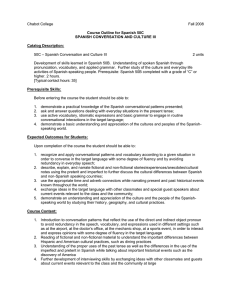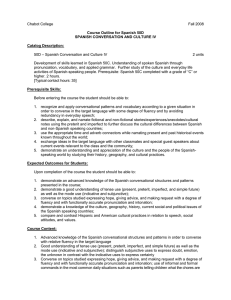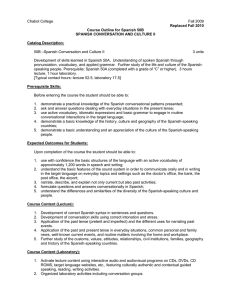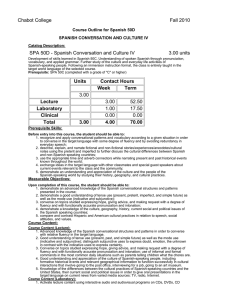Chabot College Fall 2010 SPA 50C - Spanish Conversation and Culture III
advertisement
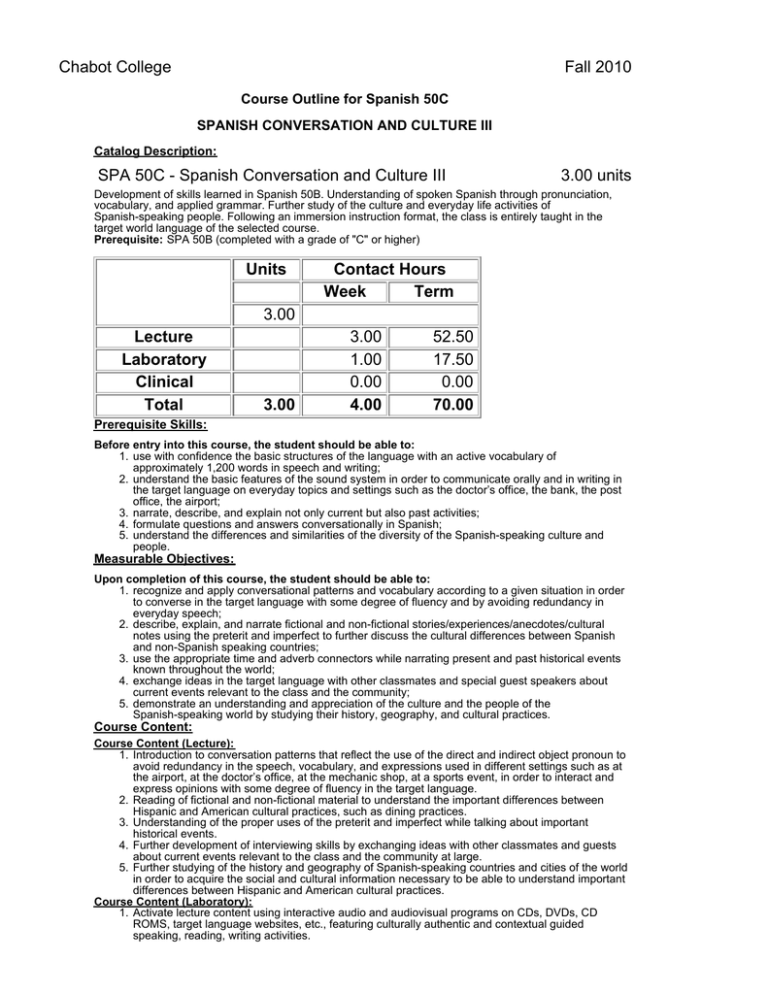
Chabot College Fall 2010 Course Outline for Spanish 50C SPANISH CONVERSATION AND CULTURE III Catalog Description: SPA 50C - Spanish Conversation and Culture III 3.00 units Development of skills learned in Spanish 50B. Understanding of spoken Spanish through pronunciation, vocabulary, and applied grammar. Further study of the culture and everyday life activities of Spanish-speaking people. Following an immersion instruction format, the class is entirely taught in the target world language of the selected course. Prerequisite: SPA 50B (completed with a grade of "C" or higher) Units Contact Hours Week Term 3.00 Lecture Laboratory Clinical Total 3.00 3.00 1.00 0.00 4.00 52.50 17.50 0.00 70.00 Prerequisite Skills: Before entry into this course, the student should be able to: 1. use with confidence the basic structures of the language with an active vocabulary of approximately 1,200 words in speech and writing; 2. understand the basic features of the sound system in order to communicate orally and in writing in the target language on everyday topics and settings such as the doctor’s office, the bank, the post office, the airport; 3. narrate, describe, and explain not only current but also past activities; 4. formulate questions and answers conversationally in Spanish; 5. understand the differences and similarities of the diversity of the Spanish-speaking culture and people. Measurable Objectives: Upon completion of this course, the student should be able to: 1. recognize and apply conversational patterns and vocabulary according to a given situation in order to converse in the target language with some degree of fluency and by avoiding redundancy in everyday speech; 2. describe, explain, and narrate fictional and non-fictional stories/experiences/anecdotes/cultural notes using the preterit and imperfect to further discuss the cultural differences between Spanish and non-Spanish speaking countries; 3. use the appropriate time and adverb connectors while narrating present and past historical events known throughout the world; 4. exchange ideas in the target language with other classmates and special guest speakers about current events relevant to the class and the community; 5. demonstrate an understanding and appreciation of the culture and the people of the Spanish-speaking world by studying their history, geography, and cultural practices. Course Content: Course Content (Lecture): 1. Introduction to conversation patterns that reflect the use of the direct and indirect object pronoun to avoid redundancy in the speech, vocabulary, and expressions used in different settings such as at the airport, at the doctor’s office, at the mechanic shop, at a sports event, in order to interact and express opinions with some degree of fluency in the target language. 2. Reading of fictional and non-fictional material to understand the important differences between Hispanic and American cultural practices, such as dining practices. 3. Understanding of the proper uses of the preterit and imperfect while talking about important historical events. 4. Further development of interviewing skills by exchanging ideas with other classmates and guests about current events relevant to the class and the community at large. 5. Further studying of the history and geography of Spanish-speaking countries and cities of the world in order to acquire the social and cultural information necessary to be able to understand important differences between Hispanic and American cultural practices. Course Content (Laboratory): 1. Activate lecture content using interactive audio and audiovisual programs on CDs, DVDs, CD ROMS, target language websites, etc., featuring culturally authentic and contextual guided speaking, reading, writing activities. 2. Organized laboratory activities including conversation groups. 3. Fundamentals of Spanish pronunciation: A. The consonant g and j B. The consonant h C. Pronunciation: linking words D. Intonation Methods of Presentation 1. 2. 3. 4. 5. Lecture/Discussion Choral/individual repetition of model speech Simulation by instructor and re-creation of dialogues and improvisation Use of supplementary materials such as audio and visual. Group Activities Assignments and Methods of Evaluating Student Progress 1. Typical Assignments A. Prepare a skit reflecting a social situation in a culturally appropriate manner using the past tense. B. Read a brief newspaper or magazine article and retell it using the imperfect and preterit. C. Watch short film clips or listen to audio material and summarize to the class. 2. Methods of Evaluating Student Progress A. Exams/Tests B. Quizzes C. Oral Presentation D. Class Participation E. Home Work F. Final Examination Textbooks (Typical): 1. 2. 3. 4. 5. 6. Garner, Lucía Caycedo (2008). ¡Claro que sí! Houghton Mifflin. Garner, Lucía Caycedo (2008). ¡Claro que sí! –(Workbook) Houghton Mifflin. Garner, Lucía Caycedo (2008). ¡Claro que sí! –(Audio material) Houghton Mifflin. Spinelli, Emily (2003). English Grammar x Students of Spanish Olivia & Hill Pr. - (2006). Larousse Concise Spanish-English English-Spanish Dictionary Larousse. - (2008). 501 Verbs in Spanish Barron's Publishing. Special Student Materials
